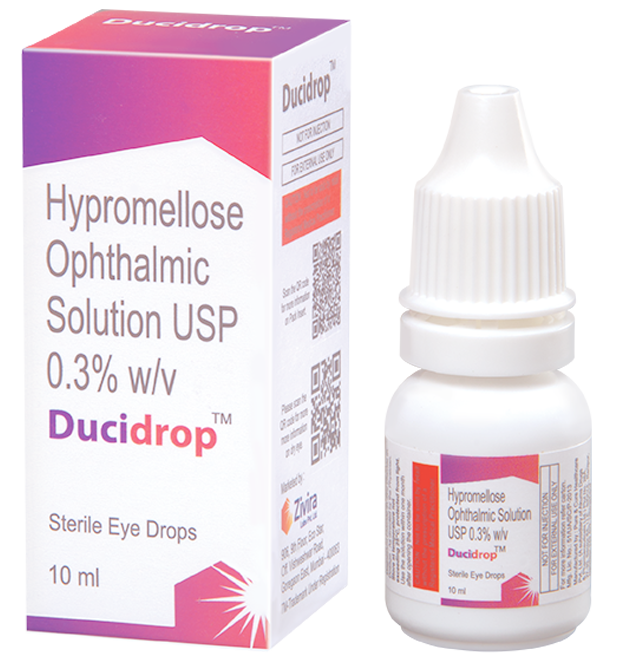DUCIDROP

Ducidrop
Hypromellose Ophthalmic Solution USP 0.3% w/v
It is indicated for the temporary relief of discomfort due to minor irritation of the eye from exposure to wind sun or other irritants for use as a protectant against further irritation or to relief dryness of then eyes.
NOTE: You should discuss the potential risks and benefits of all the eye drops with your doctor. Zivira products are prescription-based and are used to treat symptoms of dry eye. Consult your doctor for advice on using DUCIDROP ® . Your doctor will decide the dosage of DUCIDROP ® depending on your age, body weight, and severity of your condition.
-
Composition :Hydroxypropyl Methylcellulose IP 3.0 mg
Each ml Contains:Hydroxypropyl Methylcellulose IP 3.0 mg
Sodium Perborate BP 0.28% w/v
(As preservative)
Aqueous Buffered Vehicle q.s.
Inactive ingredient : Dextran 70 USP, Glycerin, Polysorbate 80 IP, Sodium
Chloride IP, Boric Acid IP, Calcium Chloride IP, Potassium Chloride IP,
Magnesium Chloride IP, Zinc Chloride IP. -
Presentation :Ducidrop (10 ml)
-
PHARMACEUTICAL FORM :Ophthalmic Solution
-
THERAPEUTIC INDICATION :It is indicated for the temporary relief of discomfort due to minor irritation of the eye from exposure to wind sun or other irritants for use as a protectant against further irritation or to relief dryness of then eyes.
-
DOSAGE AND ADMINISTRATION Posology :Adults, children and the elderly: The recommended dosage for adults, children and elderly is one or two drops topically instilled into the eye three times daily as needed, or as directed by a physician.
Method of administration: For ocular use only.
If more than one topical ophthalmic product is being used, the products should be administered at least 5 to 15 minutes apart. -
CONTRAINDICATION :It is contraindicated in patients with a known hypersensitivity to the active substance, hypromellose or to any of the excipients.
-
SPECIAL WARNINGS AND PRECAUTIONS FOR USEIt may cause transient mild stinging or temporary blurred vision. If irritation persists or worsens, or headache, eye pain, vision changes or continuous redness occur, patients should discontinue use and consult a physician or pharmacist.
The contact lenses should be removed before instillation of the drops and not reinserted earlier than 15 minutes after use.
To prevent contamination of the dropper tip and solution, care must be taken not to touch the eyelids, surrounding areas or other surfaces with the dropper tip of the bottle. Instruct patients to keep the bottle tightly closed when not in use. Instruct the patient to shake the bottle well before use. -
EFFECTS ON ABILITY TO DRIVE AND USE MACHINES :This may cause blurring of vision on instillation, which may impair the ability to drive or to use machinery. The patient should wait until these symptoms have cleared before driving or operating machinery.
-
UNDESIRABLE EFFECTS :Adverse events which have been associated with Hypromellose are given below, listed by system organ class and frequency. Frequencies are defined as: very common (≥1/10), common (≥1/100 to <1/10), uncommon (≥1/1000 to <1/100), rare (≥1/10,000 to <1/1000), very rare (<1/10,000) and not known (cannot be estimated from the available data). Within each frequency grouping, adverse events are presented in order of decreasing seriousness.
The following adverse reactions have been reported following administration of Hypromellose:
Eye disorders: Not known: transient mild stinging or vision blurred, eye pain, foreign body sensation in eyes, eye irritation, and ocular hyperaemi. -
OVERDOSE :Due to the characteristics of this preparation, no toxic effects are to be expected with an ocular overdose of this product. It is not systemically absorbed.
-
PHARMACOLOGICAL PROPERTIES Pharmacodynamic properties :Pharmacotherapeutic Group: Ophthalmologicals: other ophthalmologicals. Hydroxypropyl methylcellulose or Hypromellose is a soothing emollient solution with properties and uses similar to those of methylcellulose. Its advantages over methylcellulose are that mucilages of hypromellose have greater clarity and fewer undispersed fibres are usually present. It prolongs the action of medicated eye drops and is used as artificial tears to prevent damage to the cornea in dry eye syndromes.
-
Pharmacokinetic properties :Hypromellose is an inert substance. It has no pharmacological activity and not absorbed systemically. Hence, the pharmacokinetic properties have not been studied.
-
INCOMPATABILITES :Not known.
-
STORAGE AND HANDLING INSTRUCTIONS Store at temperature not exceeding 25°C, protected from light. :Keep out of reach of children.
-
PACKAGING INFORMATION :Ducidrop Eye Drops is available in a 10 ml pack.
-
USE IN SPECIFIC POPULATIONS
- Pregnancy There are no or limited amount of data from the use of ophthalmic hypromellose in pregnant women. Systemic exposure to hypromellose following topical ocular administration is negligible and the product has no pharmacological properties.
- Nursing Mothers It is unknown whether topical hypromellose/metabolites are excreted in human milk. No effects on the breastfed newborn/infant are anticipated since the systemic exposure of the breast-feeding women to hypromellose is negligible. In addition to this, hypromellose is pharmacologically inert.
- Fertility Studies have not been performed to evaluate the effect of topical ocular administration of hypromellose on fertility. Hypromellose is a pharmacologically inert compound and it would not be expected to have any effect on fertility.
NOTE: Call your doctor or get medical care immediately if you develop any side effects.
The associated risks and benefits of using Ducidrop ® in pregnant women and breastfeeding mothers are unclear. However, no preventive measures are advised for using Ducidrop ® products in pregnant women. Consult your doctor for advice.